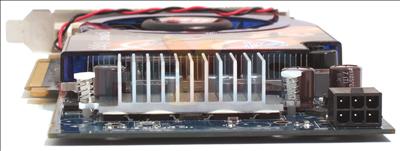Sapphire Radeon HD 3850 1GiB
As we know, Sapphire currently lists four DX10.1-toting Radeon HD 3850 SKUs in its line-up.There's the default model, characterised by 256MiB of onboard GDDR3 memory running at an effective 1,658MHz and the core/shaders at 669MHz. Then there's the ULTIMATE SKU, which ships at the same frequencies but does so with zero-noise cooling, thanks to the passive design. Thirdly, there's the 512MiB model, which matches the 3870's memory count, albeit with slower speeds.
Lastly, the review model, shown below, ships with 1GiB memory, useful for high image-quality and high-resolution settings, but at the cost of a higher street price - currently around £120 for the retail 'lite' package.
Sapphire keeps the GDDR3 memory speed at roughly the same levels as the other HD 3850-based cards, at 1,656MHz, but increases the engine/shader clock to 702MHz. That still puts it some way behind a stock-clocked Radeon HD 3870 512MiB - which is based on the same architecture - that ships with 777/2,252MHz clocks, You get more onboard memory at the expense of slower speeds, then.
We noted that the single-slot-taking cooler was slightly noisy when idling and fairly noisy when stressed with continuous 3D load. Now, with an HD 3870's cooler being quieter in both modes, we're surprised that Sapphire didn't tune the fan better.
The 1GiB GDDR3 memory is all contained on the other side, though. Two 'golden fingers' offer up-to four-card rendering through ATI's CrossFireX technology.
Common to all three-series cards is a PCIe 2.0 x16 interface to the motherboard - handy for quickly streaming data from the CPU and main memory, but not so important for a mid-range card like this.
The six-pin PCIe connector is present on the default-clocked 256MiB SKU, so no surprises in seeing it here. The card will draw around 90W under load, and Sapphire recommends a 450W PSU for single-card usage and a 550W model for CrossFireX.
The 2D feature-set is strong, including HDMI pass-through via the dual-link DVI ports, and thus providing one-cable audio/video support for external displays.
ATI adheres to Microsoft's Universal Audio Architecture for Windows Vista, meaning that you won't need to connect additional cables for pushing sound through, a la NVIDIA's current cards.
Summary
A Radeon HD 3850 can be thought of a slower-clocked Radeon HD 3870: the underlying architecture is identical. Sapphire has attempted to leverage the current low pricing for GDDR3 by adding a 1GiB framebuffer to this model, along with higher-than-default engine/shader speeds.
The downside is price, unfortunately, as the card retails for £120, which is some £27 higher than a stock-clocked Radeon HD 3870 512MiB.














